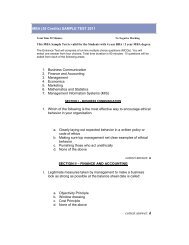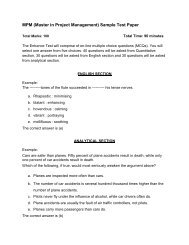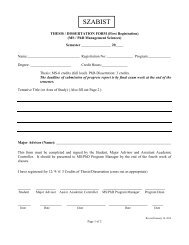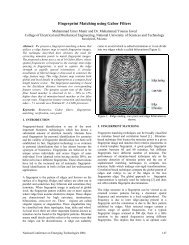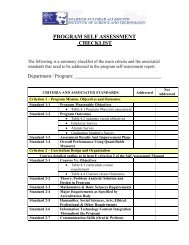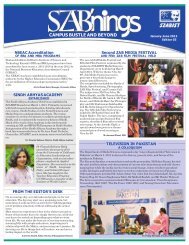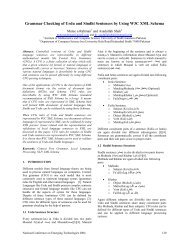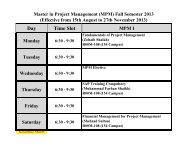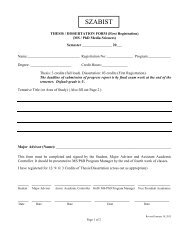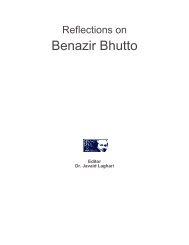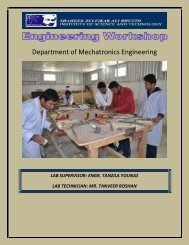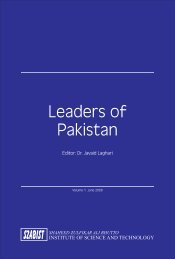Syntactical Translation System for English to Sindhi ... - SZABIST
Syntactical Translation System for English to Sindhi ... - SZABIST
Syntactical Translation System for English to Sindhi ... - SZABIST
You also want an ePaper? Increase the reach of your titles
YUMPU automatically turns print PDFs into web optimized ePapers that Google loves.
meaning of base <strong>for</strong>m of adjective is required. For the<br />
meaning of comparative adjective only “ ڌيכو ” is added<br />
be<strong>for</strong>e the meaning of base <strong>for</strong>m of adjective, and in the<br />
same way by adding word ,تمام“ meaning of superlative<br />
adjective is achieved.<br />
Example Hard Harder Hardest<br />
سخت<br />
وڌيك سخت تمام سخت Big Bigger Biggest<br />
تمام وڏو وڌيك وڏو<br />
وڏو<br />
2.4 <strong>Translation</strong> of Numbers Written in Words<br />
The numbers in <strong>English</strong>, which are written in words, is a<br />
tedious task <strong>to</strong> examine and convert <strong>to</strong> <strong>Sindhi</strong>. An<br />
algorithm is designed <strong>for</strong> this conversion, which nicely<br />
converts even very long numbers in<strong>to</strong> numerical <strong>for</strong>mat,<br />
and then with the help of database, the numerical value is<br />
converted <strong>to</strong> words in <strong>Sindhi</strong>.<br />
Usually, the largest value in <strong>English</strong> is billion. The values<br />
larger then Billion are important <strong>for</strong> scientists and not <strong>for</strong><br />
common man. So billion is supposed <strong>to</strong> be the largest<br />
word used in daily transactions.<br />
The algorithm follows the following steps in order <strong>to</strong><br />
convert a number made up of words in<strong>to</strong> the<br />
corresponding numerical value:<br />
1. Recognize a combination of continues words <strong>to</strong> be a<br />
number from the input collection of words<br />
representing a sentence.<br />
2. Take the first word from the stream. If the word is<br />
one of the following:<br />
“one”, “two”, …, “ninety”, then<br />
i) If the current word is the last word then assign the<br />
word’s value <strong>to</strong> the “temp” variable.<br />
ii) If the current word is not the last one, add the<br />
word’s value <strong>to</strong> the “temp” variable.<br />
3. If the word is “hundred” then<br />
i) If it is the last word in stream, assign the word’s<br />
value <strong>to</strong> the temp variable<br />
ii) Else, multiply the word’s value with the “temp”<br />
variable<br />
4. if the word is “thousand”, “million”, “billion”, …,<br />
then multiply “temp’s” value <strong>to</strong> the word, and put the<br />
value in appropriate variable (“thousand”, “million”,<br />
etc.). Assign the value Zero <strong>to</strong> the “temp” variable<br />
5. Take the next word out from the array of words of the<br />
number, and repeat steps 2 <strong>to</strong> 4 <strong>for</strong> it.<br />
6. Reaching the end, the final numerical value of the<br />
number can be calculated as:<br />
Number = Billion + Million + Thousand<br />
+ temp<br />
In general the algorithm says that, if any word has a value<br />
larger than the previous word, multiply both. Otherwise if<br />
any word has a value smaller than the previous word, add<br />
the word <strong>to</strong> the <strong>to</strong>tal.<br />
After getting the value of the number in words, it is<br />
translated in<strong>to</strong> words in <strong>Sindhi</strong>. This is done by first<br />
dividing the number in<strong>to</strong> its component parts. <strong>Sindhi</strong> has a<br />
unit system different from that of <strong>English</strong>. It uses<br />
multiples of hundred <strong>for</strong> describing the units, in contrast<br />
with <strong>English</strong> that uses multiples of thousand <strong>for</strong> describing<br />
the units. <strong>Sindhi</strong>’s units are given in table 6:<br />
Table 6. Unit system <strong>for</strong> <strong>Sindhi</strong><br />
<strong>English</strong> Value <strong>Sindhi</strong><br />
Hundred 100 Sow<br />
Thousand 1,000 Hazar<br />
Hundred Thousand 1,00,000 Lac<br />
Ten Million 1,00,00,000 Crore<br />
Billion 1,00,00,00,000 Arb<br />
First, the input numerical value is converted in<strong>to</strong> its <strong>Sindhi</strong><br />
component parts. Then with the help of database, the<br />
proper names of units are found from database and values<br />
and then they are put in proper order, <strong>to</strong> get the number in<br />
words of <strong>Sindhi</strong>.<br />
3. CONCLUSION AND FUTURE WORK<br />
A language translation system has been developed on a<br />
very basic level that will help the developers <strong>to</strong> get in the<br />
world of language translation. Researchers have tried <strong>to</strong><br />
cover the three levels of grammar tenses (Present,<br />
Continuous & Past and their four sub tenses (Indefinite,<br />
Continuous, Perfect & Perfect Continuous).<br />
The present research successfully defines rules <strong>for</strong> <strong>Sindhi</strong><br />
language through which structure of <strong>Sindhi</strong> sentence can<br />
be identified.<br />
The translation of sentences that contain the model<br />
auxiliaries, <strong>for</strong> example can, and would and so on is also<br />
achieved.<br />
This project handles the problem of proper noun. It takes<br />
proper nouns and au<strong>to</strong>matically translates them in <strong>Sindhi</strong><br />
word, without the help of database.<br />
The present work in no way can be termed as complete<br />
and fully operational. A number of enhancements and<br />
refinements are possible. During the research more stress<br />
was on functionality there<strong>for</strong>e the database is limited and<br />
should be enhanced in future.<br />
In the process of translation there were many ambiguities,<br />
few of them have been resolved, others still have <strong>to</strong> be<br />
addressed, e.g Semantic rules are not applied; these rules<br />
should be implemented in future in order <strong>to</strong> increase the<br />
accuracy of translation.<br />
The project is not targeted <strong>for</strong> complex sentences and the<br />
sentences that contain idioms. It is recommended <strong>for</strong> the<br />
future researchers <strong>to</strong> work on the complex sentences and<br />
idioms.<br />
National Conference on Emerging Technologies 2004 114



